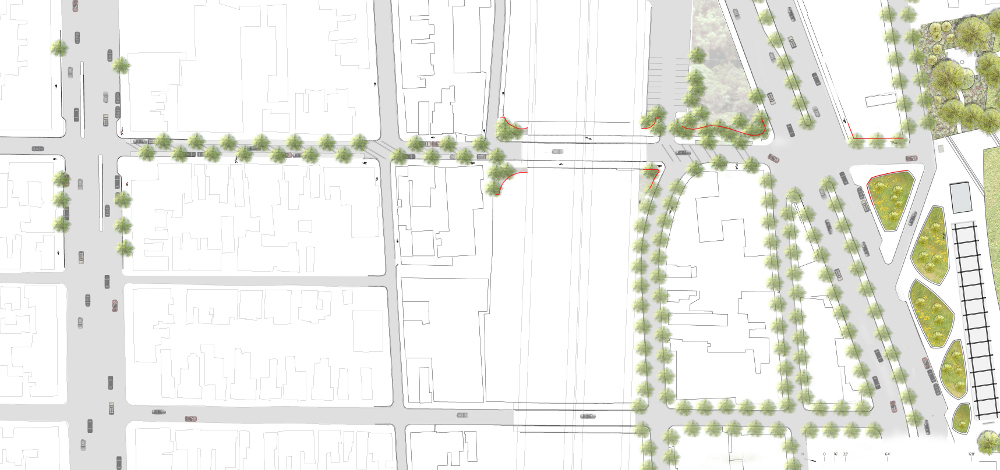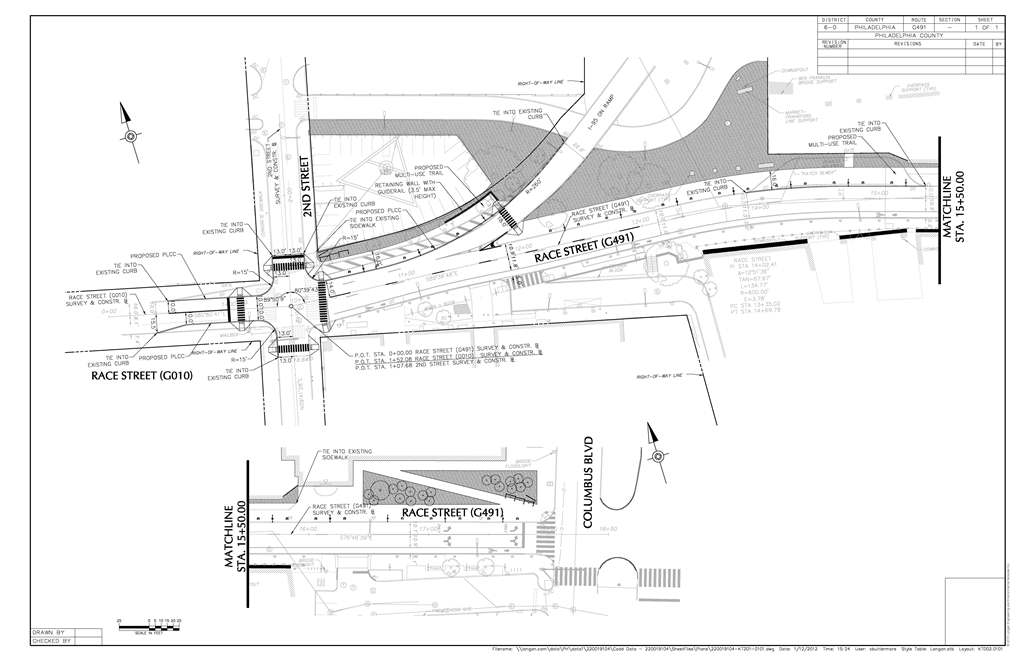Neighborhood-to-waterfront connector street projects moving forward
Progress continues on three street improvement projects designed to better link Philadelphia neighborhoods with the Central Delaware Riverfront through improved pedestrian and bicycle access, lighting, landscaping and signage.
Delaware River Waterfront Corporation staff and board committee members gave reports on the second phase of the Race Street Connector, Columbia Avenue Connector and Spring Garden Street Connector.
Race Street is the project that’s farthest along, with the south side portion of the project already completed. Planning for phase II is underway, and it’s been considerably more complicated, DRWC Vice President Joe Forkin said. For one thing, there is currently no sidewalk at all on that side of Race Street from 2nd to the waterfront. For another, any pedestrians or bicyclists brought there would have to somehow get across the I-95 on-ramp.
But Forkin’s big Race Street news is that PennDOT and the city’s transportation and utilities department have agreed that a multi-purpose sidewalk/bikepath can, in fact, cross right over the ramp. Deputy Mayor for Transportation and Utilities Rina Cutler is also a DRWC board member, and she called PennDOT’s decision to allow this astonishing. “The fact that PennDOT allowed this is almost beyond belief,” she said.
Exactly how the traversing will happen has yet to be determined, Forkin said. PennDOT asked for a study to see if a traffic signal is needed at the place where pedestrians will cross. “We’re doing that now,” he said.
Design work for the underpass section of the Columbia Avenue Connector, which will link Fishtown to the waterfront, has been completed by Studio Bryan Hanes, and the designs given to PennDOT, DRWC Director of Planning Sarah Thorp said. PennDOT is redoing the Columbia Avenue underpass as part of its I-95 improvement project. Because PennDOT has a long bidding process, construction won’t begin in this area, and is expected to take 18 months, Thorp said. “Our piece of that – the underpass – probably won’t be until the very end, so even though we have completed the designs, it will be 18 months to two years before the improvements are done,” Thorp said.
The underpass design includes LED lighting to make the underpass safer at night and a decorative imprint in the concrete. The underpasses at nearby Marlborough and Shackamaxon streets will get the same treatments, Thorp said.
But Columbia Street is a major connector in the Delaware River Waterfront Master Plan, and there are two other phases on that street: the section from the underpass East to Delaware Avenue and Penn Treaty Park, and the section from the underpass west to Girard Avenue.
The portion between the highway and the park includes landscaping and a public art component. Local artist Donald Lipski, whose Kensington studio is not far from Columbia Street, has been chosen to do the art. Lipski has done public work projects in cities around the country, including New York, Miami, Chicago, Fort Worth and Washington, D.C. To learn more about him, see his website here. When he submits designs, they will go to the city’s art commission for approval, Thorp said.
While some conceptual designs have been finished for the area between the underpass and Girard Avenue, that’s as far as things will go for now, Thorp said, because that section is unfunded.
DRWC Board Member Bill Hankowsky asked who would be responsible for the maintenance of the connector project, once completed.
Thorp said DRWC would maintain the art and any landscaping – although most of that will be in the unfunded and unscheduled western portion of the project. The streets department has agreed to maintain the LED light fixtures and PennDOT will maintain the walls, painting over any graffiti. The walls were specifically designed to PennDOT standards so that no special graffiti removal techniques would be needed, Thorp said.
DRWC President Tom Corcoran said the impact of PennDOT’s decision to reach out to DRWC and other community organizations so that community plans could be incorporated into the overpass and other I-95 related work is huge.
“Our total investment is probably several hundred thousand in design, and maybe $250,000 in the art component. But the value of the PennDOT improvements, that they will pay for, using our design, is probably in the order of magnitude of a million and a half to $2 million,” he said.
The newest of DRWC’s connector street projects is also the largest and the most complicated: Spring Garden Street, which links Northern Liberties to the waterfront.
The underpass is wide, as I-95 above has five lanes of traffic in each direction and a Frankford-Market El stop, Thorp said.
Cutler arranged a meeting of the many stakeholders in this project – city streets and the water department, SEPTA, the mural arts program, the Pennsylvania Environmental Council and Northern Liberties Neighbors Association among them. There were so many people working on so many different projects in the area that it was essential to get everyone together to discuss what was happening and what stage it was in, Cutler said.
Representatives from these groups have helped DRWC work on a request for proposals for design work on the project, Thorp said. She anticipates the RFP will go out within a few months.
Cutler said there has been “much discussion without, yet, consensus” on where a bikelane would go on an improved Spring Garden Street. Would it be in the center? Or in the center in some point, and then out to the curb? “There has been some historically interesting parking in the center lane by the fire department,” she said, and they are not keen on the idea of losing those spaces.
Thorp said a likely possibility is making improvements only from the curbline out on the south and north sides, leaving the center of the road alone until more consensus can be reached.
Another complication: Improvements to the subway station – or more specifically, the stairs and escalators leading to and from it – are crucial not only to the success of the connector itself, but to nearby future development, including plans to attract mixed-use development to the Festival Pier site at the foot of Spring Garden.
SEPTA has recently re-done the actual station, but redoing the access to it is not on the top of the capital plan list without federal and state funding, Cutler said.
The problem is that the access stairwells, contained within the underpass, are cramped, and they can’t get bigger unless there is more space is created. “I’m trying to get PennDOT to put expansion into their project” slated for 2014, Cutler said, so that SEPTA has space to work with.
Right now, there is an escalator, but no elevator, Cutler said, and the second any work begins, Americans With Disabilities Act requirements for an elevator will be triggered.
The SEPTA stop and underpass work has implications for waterfront projects, too, Corcoran said. DRWC wants to build transit-oriented development at Festival Pier, Corcoran said, but that stop is just not transit friendly now. Work on lighting and streetscape in the near term will help, he said, while the more complicated things are worked out.
Reach the reporter at kgates@planphilly.com.
WHYY is your source for fact-based, in-depth journalism and information. As a nonprofit organization, we rely on financial support from readers like you. Please give today.





